Hydrophyte communities in the Tam Giang - Cau Hai lagoon
Seagrass ecosystem is one of three
important marine ecosystems (mangroves,
seagrasses, corals). Seagrass ecosystem has the
function of regulating the environment,
supplying, producing and information. The role
of seagrasses is very important, their
participation in the sea and ocean nutrition
cycle is estimated at about 3.8 trillion USD and
the average value is 212,000 USD/1 ha/year
[1]. In addition to the ecological value of the
environment, seagrass is also used directly in
many national economic sectors (paper,
chemicals, explosives, soundproofing,
medicine, food, fertilizer, animal feed,.).
Tam Giang - Cau Hai (TG - CH) lagoon is
one of the places having well-developed
seagrass beds, with the largest seagrass
distribution area in Vietnam [2, 3]. The total
economic value of every 1.000 hectares of
seagrass here is worth about 2.4 million USD.
However, assessments in 2010 showed that the
quality of seagrass beds (area, coverage and
biomass) was reduced by 40–50% compared to
the 1990s, leading to the reduction of resources
of biological species at an alarming level [3]. In
order to protect, rehabilitate and sustainably
develop seagrass resources in the Tam Giang -
Cau Hai lagoon, an appropriate management,
protection and exploitation plan is required.
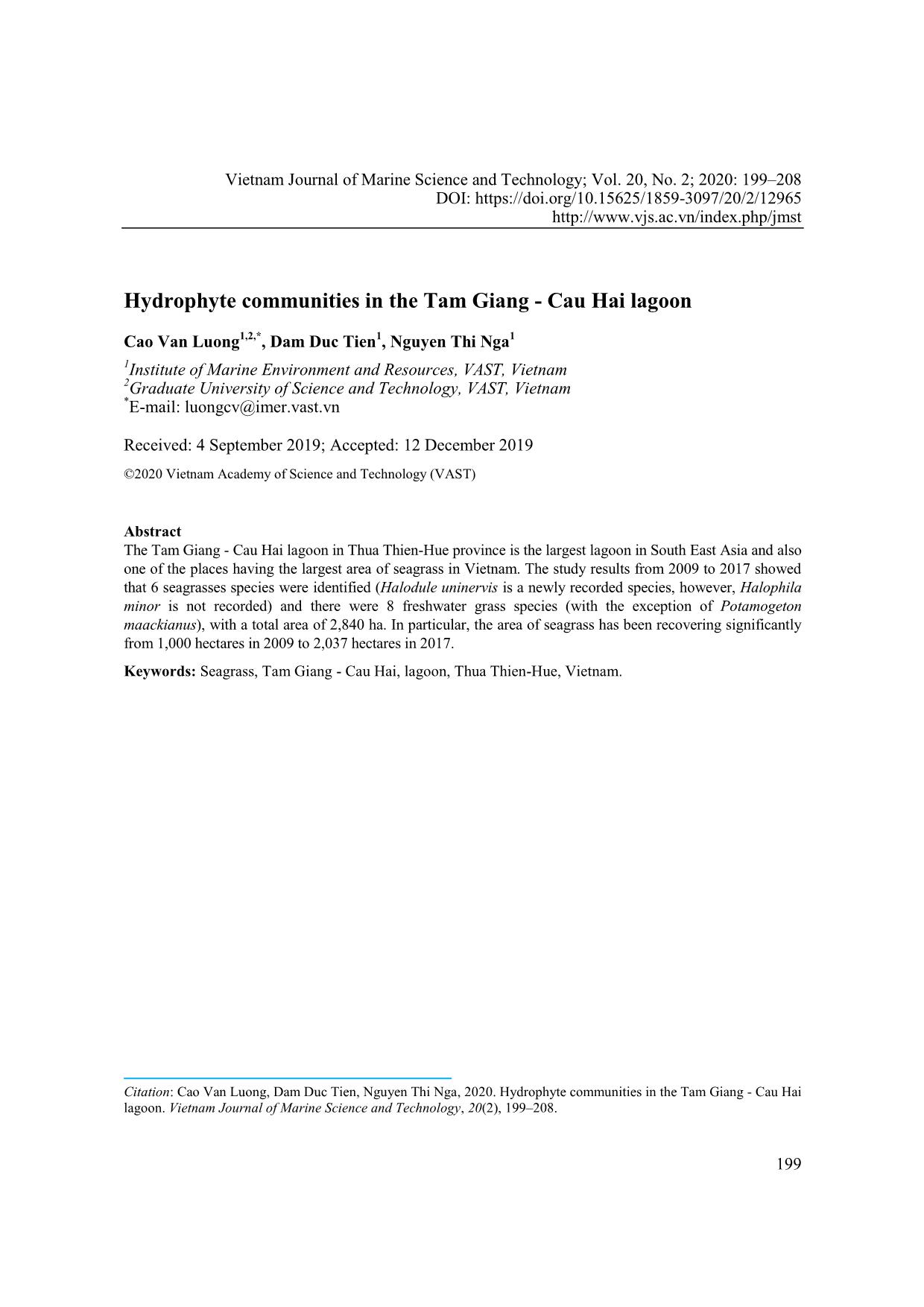
Trang 1
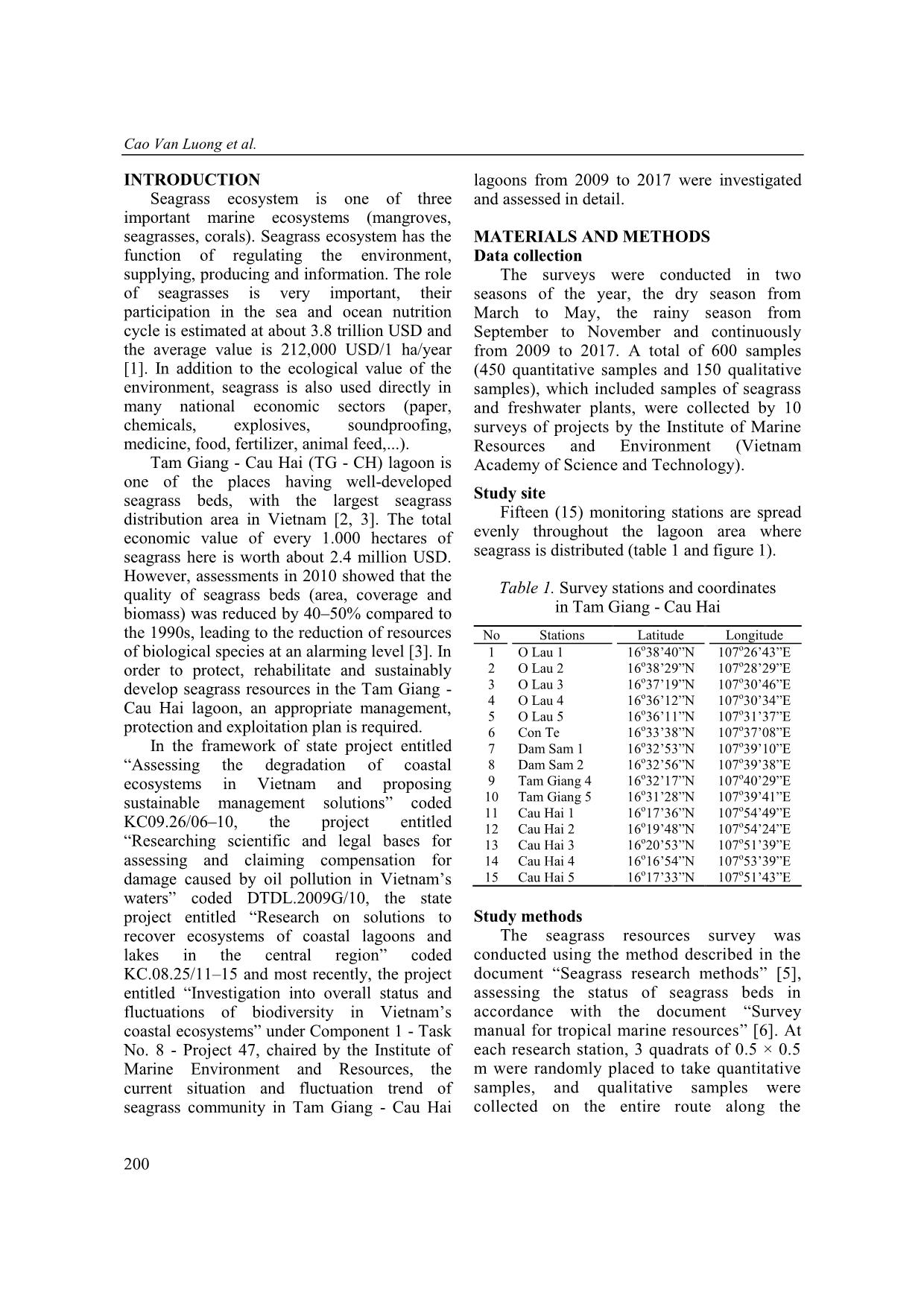
Trang 2
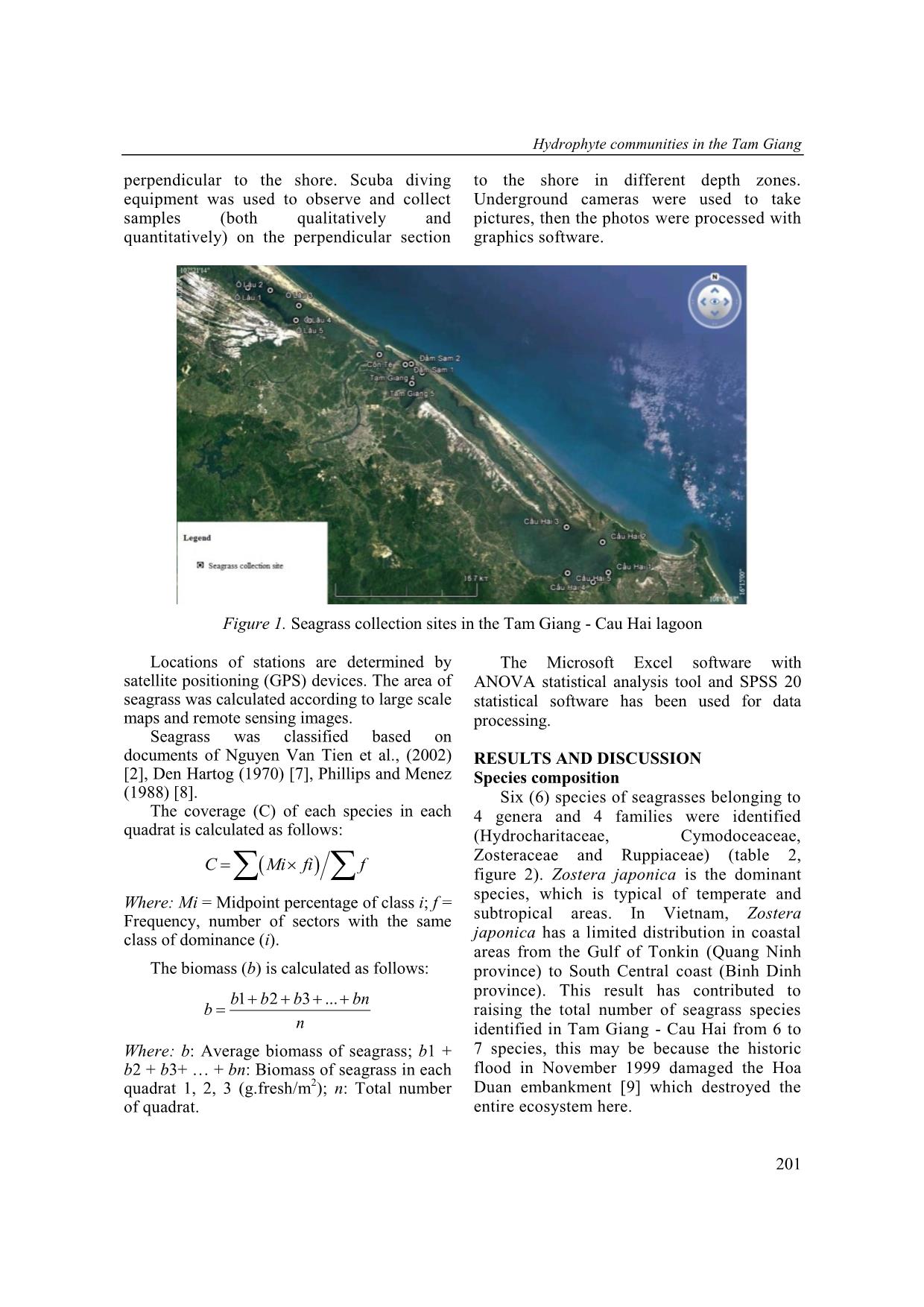
Trang 3
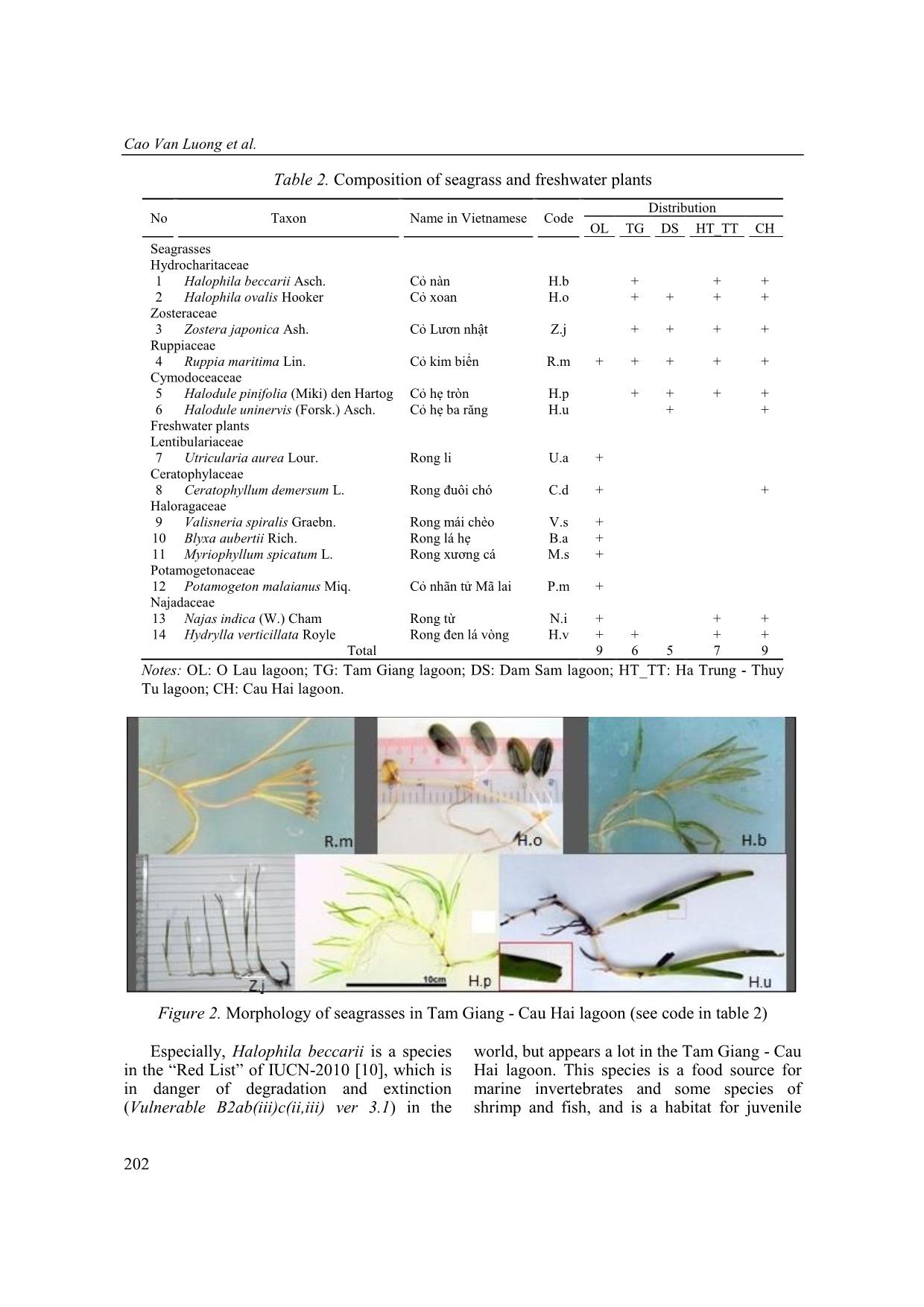
Trang 4
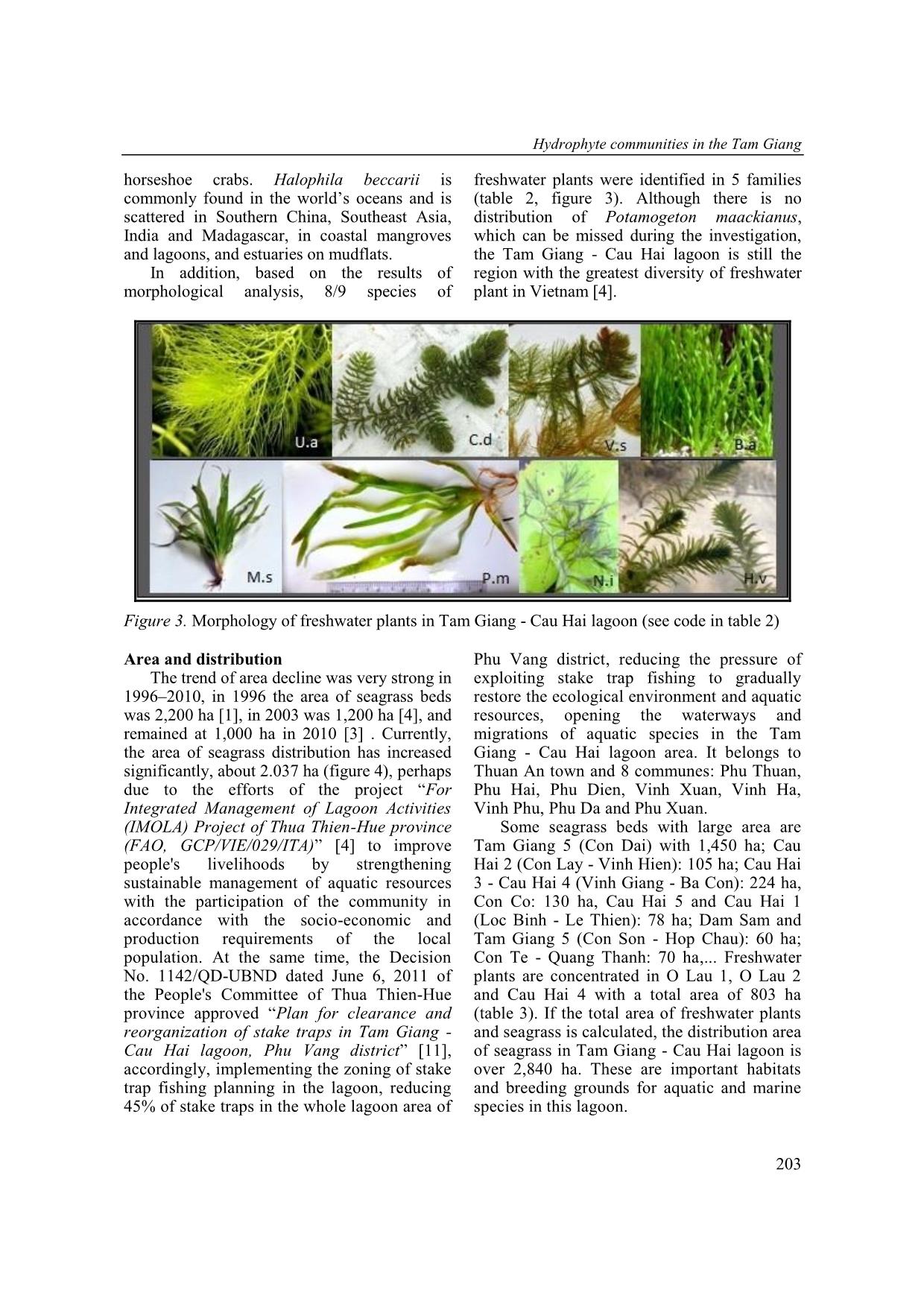
Trang 5
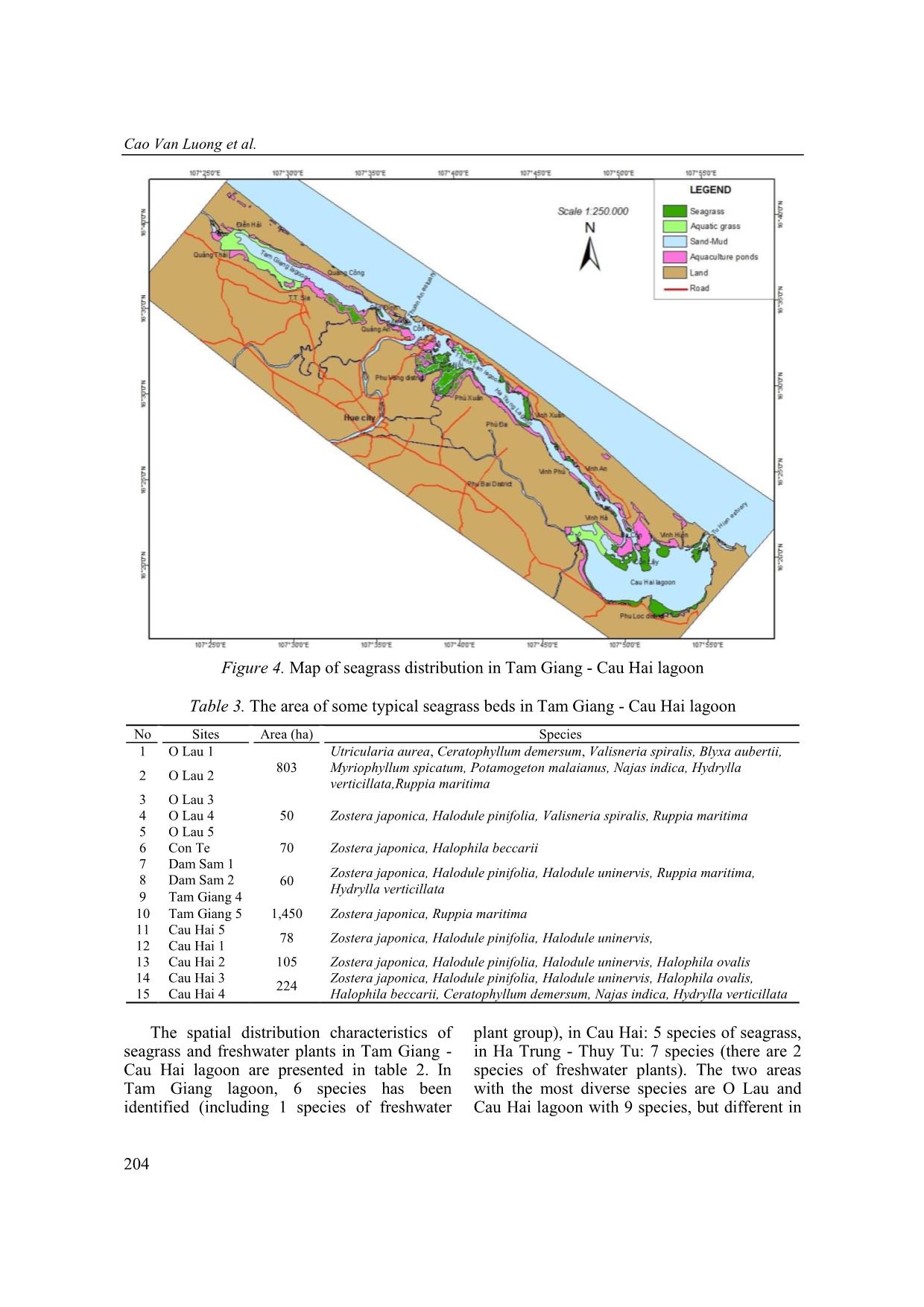
Trang 6
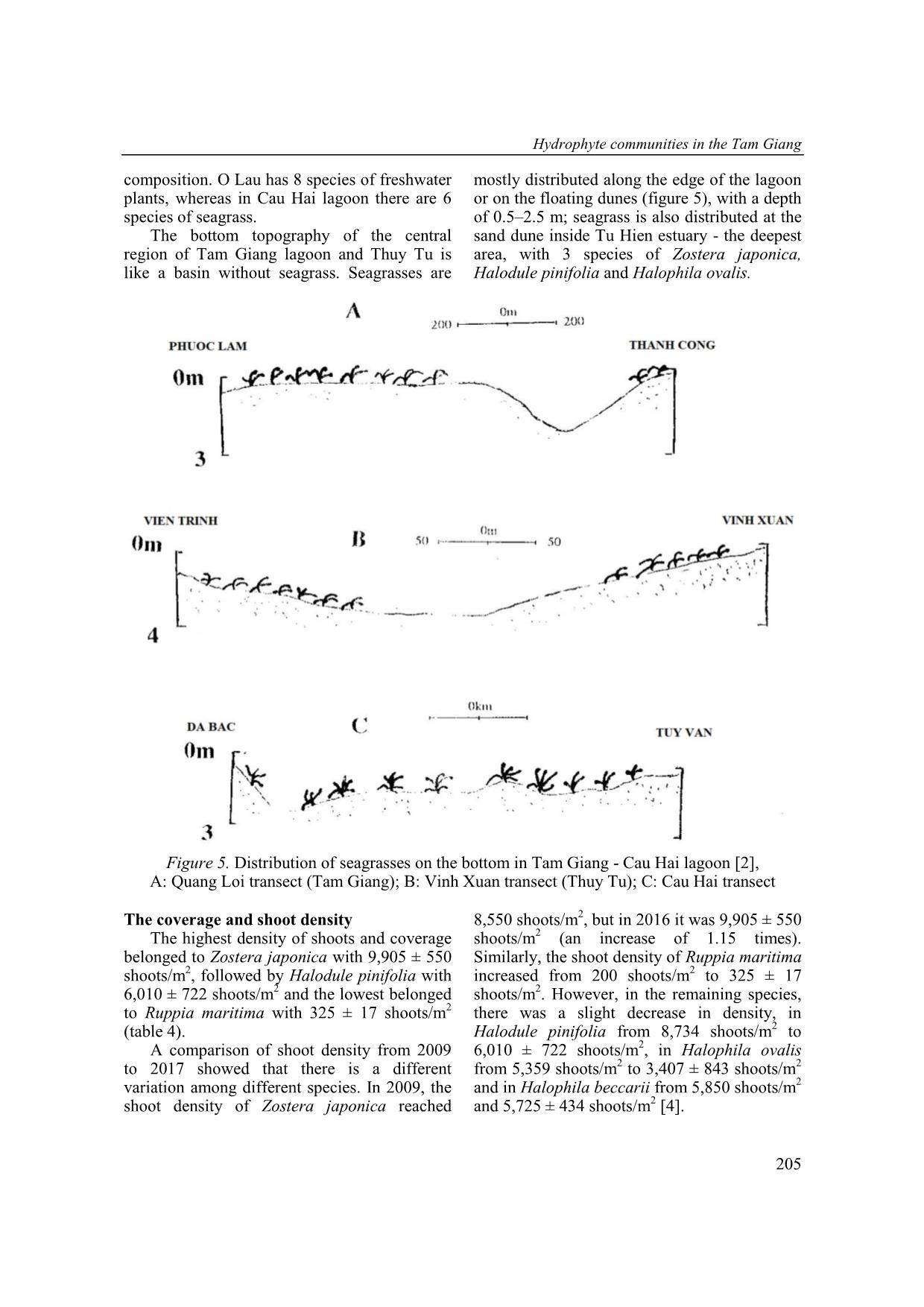
Trang 7
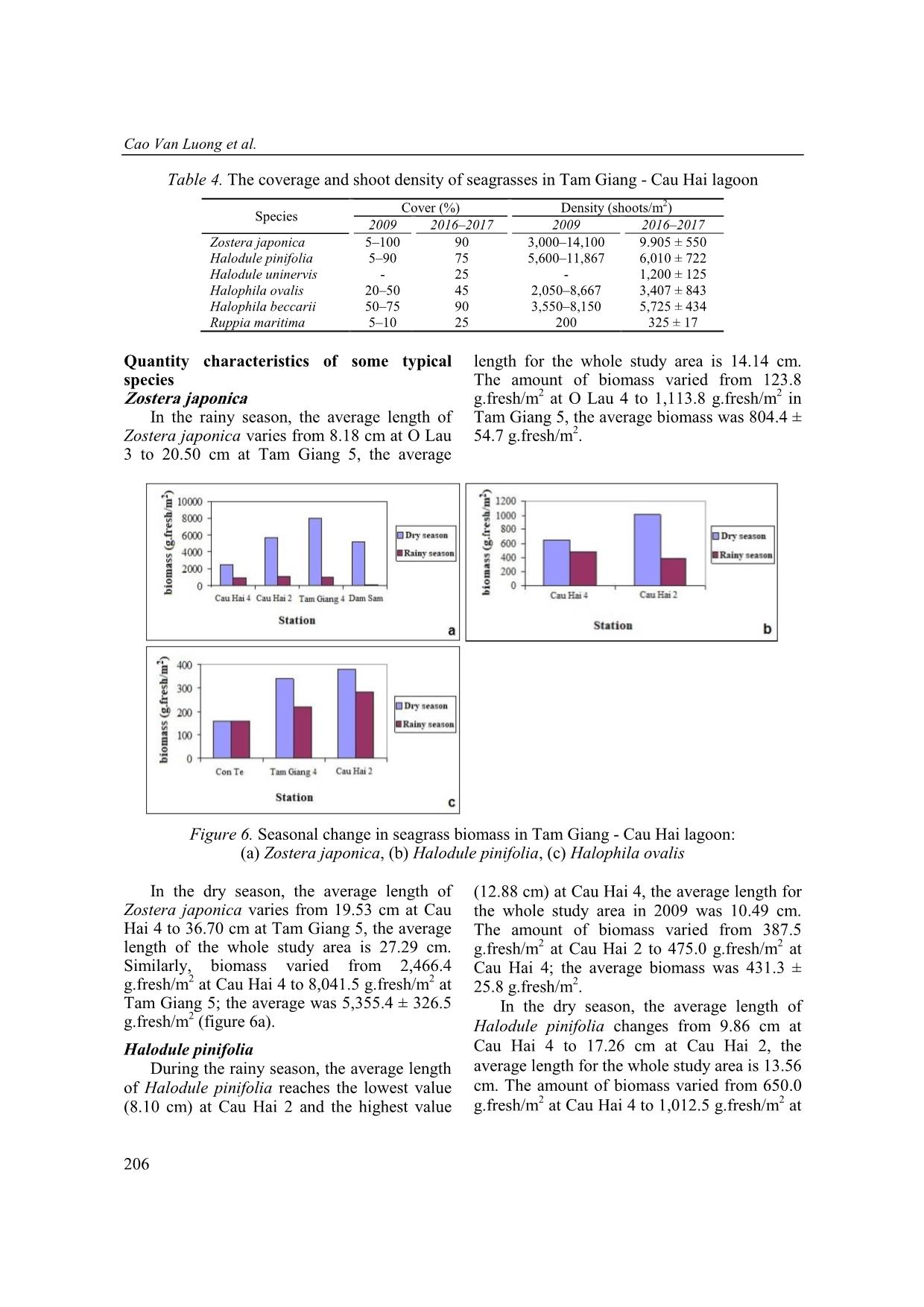
Trang 8
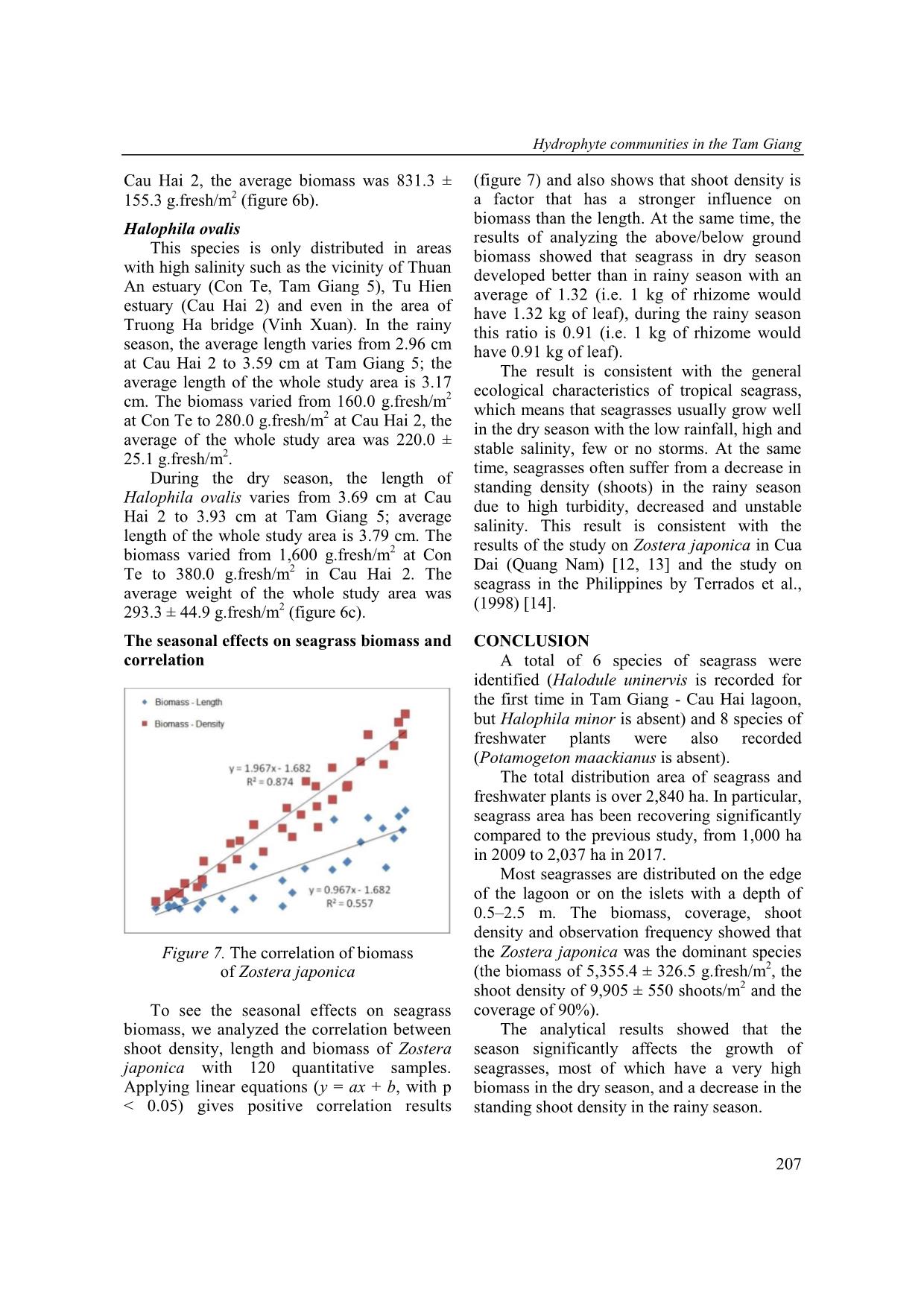
Trang 9
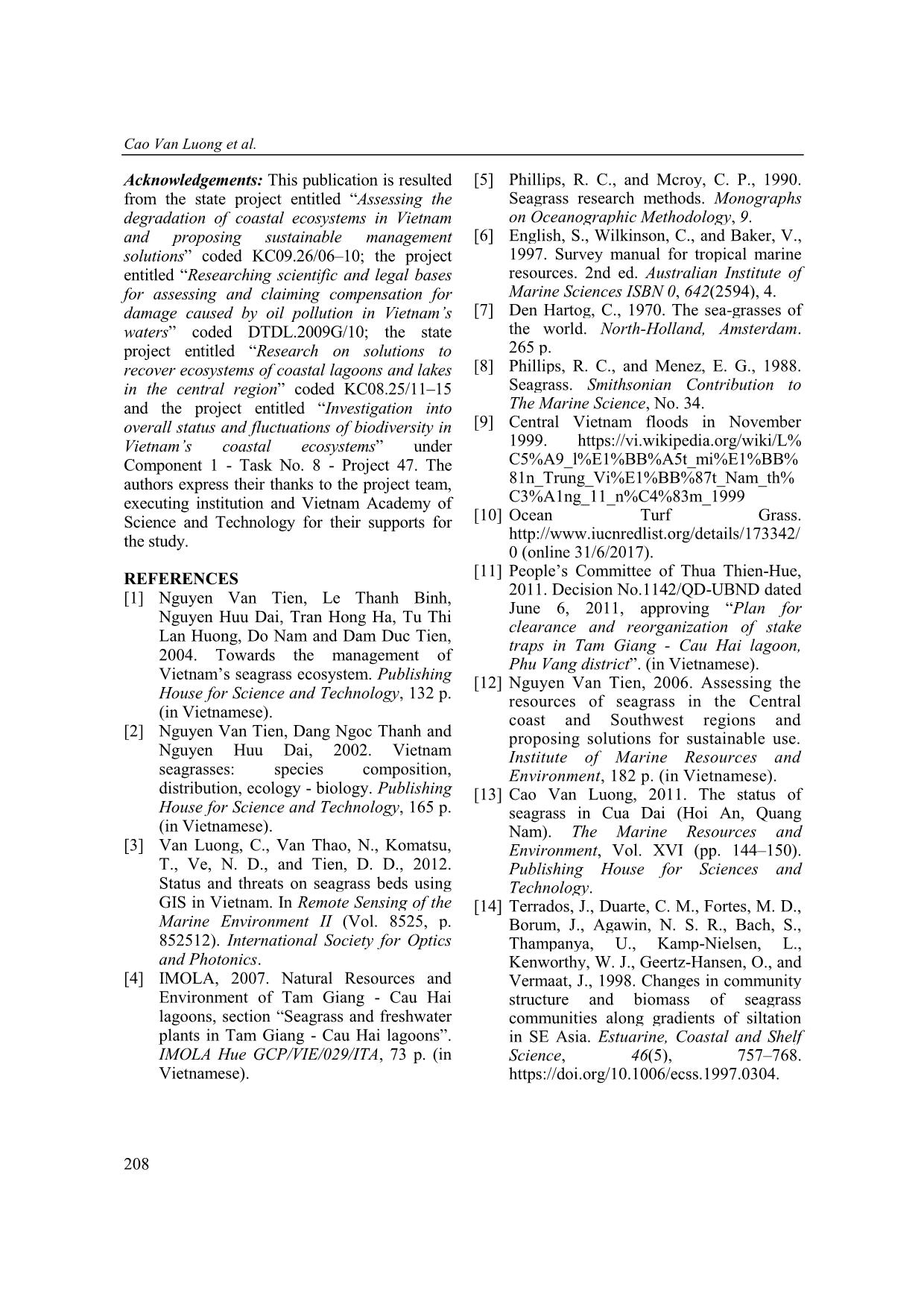
Trang 10
Tóm tắt nội dung tài liệu: Hydrophyte communities in the Tam Giang - Cau Hai lagoon
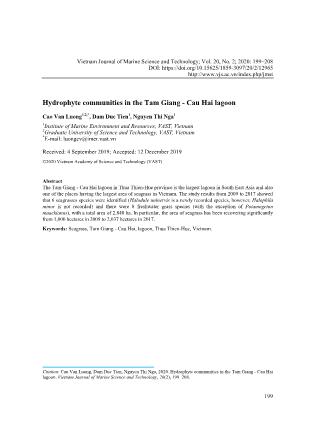
ea decline was very strong in 1996–2010, in 1996 the area of seagrass beds was 2,200 ha [1], in 2003 was 1,200 ha [4], and remained at 1,000 ha in 2010 [3] . Currently, the area of seagrass distribution has increased significantly, about 2.037 ha (figure 4), perhaps due to the efforts of the project “For Integrated Management of Lagoon Activities (IMOLA) Project of Thua Thien-Hue province (FAO, GCP/VIE/029/ITA)” [4] to improve people's livelihoods by strengthening sustainable management of aquatic resources with the participation of the community in accordance with the socio-economic and production requirements of the local population. At the same time, the Decision No. 1142/QD-UBND dated June 6, 2011 of the People's Committee of Thua Thien-Hue province approved “Plan for clearance and reorganization of stake traps in Tam Giang - Cau Hai lagoon, Phu Vang district” [11], accordingly, implementing the zoning of stake trap fishing planning in the lagoon, reducing 45% of stake traps in the whole lagoon area of Phu Vang district, reducing the pressure of exploiting stake trap fishing to gradually restore the ecological environment and aquatic resources, opening the waterways and migrations of aquatic species in the Tam Giang - Cau Hai lagoon area. It belongs to Thuan An town and 8 communes: Phu Thuan, Phu Hai, Phu Dien, Vinh Xuan, Vinh Ha, Vinh Phu, Phu Da and Phu Xuan. Some seagrass beds with large area are Tam Giang 5 (Con Dai) with 1,450 ha; Cau Hai 2 (Con Lay - Vinh Hien): 105 ha; Cau Hai 3 - Cau Hai 4 (Vinh Giang - Ba Con): 224 ha, Con Co: 130 ha, Cau Hai 5 and Cau Hai 1 (Loc Binh - Le Thien): 78 ha; Dam Sam and Tam Giang 5 (Con Son - Hop Chau): 60 ha; Con Te - Quang Thanh: 70 ha,... Freshwater plants are concentrated in O Lau 1, O Lau 2 and Cau Hai 4 with a total area of 803 ha (table 3). If the total area of freshwater plants and seagrass is calculated, the distribution area of seagrass in Tam Giang - Cau Hai lagoon is over 2,840 ha. These are important habitats and breeding grounds for aquatic and marine species in this lagoon. Cao Van Luong et al. 204 Figure 4. Map of seagrass distribution in Tam Giang - Cau Hai lagoon Table 3. The area of some typical seagrass beds in Tam Giang - Cau Hai lagoon No Sites Area (ha) Species 1 O Lau 1 803 Utricularia aurea, Ceratophyllum demersum, Valisneria spiralis, Blyxa aubertii, Myriophyllum spicatum, Potamogeton malaianus, Najas indica, Hydrylla verticillata,Ruppia maritima 2 O Lau 2 3 O Lau 3 50 Zostera japonica, Halodule pinifolia, Valisneria spiralis, Ruppia maritima 4 O Lau 4 5 O Lau 5 6 Con Te 70 Zostera japonica, Halophila beccarii 7 Dam Sam 1 60 Zostera japonica, Halodule pinifolia, Halodule uninervis, Ruppia maritima, Hydrylla verticillata 8 Dam Sam 2 9 Tam Giang 4 10 Tam Giang 5 1,450 Zostera japonica, Ruppia maritima 11 Cau Hai 5 78 Zostera japonica, Halodule pinifolia, Halodule uninervis, 12 Cau Hai 1 13 Cau Hai 2 105 Zostera japonica, Halodule pinifolia, Halodule uninervis, Halophila ovalis 14 Cau Hai 3 224 Zostera japonica, Halodule pinifolia, Halodule uninervis, Halophila ovalis, Halophila beccarii, Ceratophyllum demersum, Najas indica, Hydrylla verticillata 15 Cau Hai 4 The spatial distribution characteristics of seagrass and freshwater plants in Tam Giang - Cau Hai lagoon are presented in table 2. In Tam Giang lagoon, 6 species has been identified (including 1 species of freshwater plant group), in Cau Hai: 5 species of seagrass, in Ha Trung - Thuy Tu: 7 species (there are 2 species of freshwater plants). The two areas with the most diverse species are O Lau and Cau Hai lagoon with 9 species, but different in Hydrophyte communities in the Tam Giang 205 composition. O Lau has 8 species of freshwater plants, whereas in Cau Hai lagoon there are 6 species of seagrass. The bottom topography of the central region of Tam Giang lagoon and Thuy Tu is like a basin without seagrass. Seagrasses are mostly distributed along the edge of the lagoon or on the floating dunes (figure 5), with a depth of 0.5–2.5 m; seagrass is also distributed at the sand dune inside Tu Hien estuary - the deepest area, with 3 species of Zostera japonica, Halodule pinifolia and Halophila ovalis. Figure 5. Distribution of seagrasses on the bottom in Tam Giang - Cau Hai lagoon [2], A: Quang Loi transect (Tam Giang); B: Vinh Xuan transect (Thuy Tu); C: Cau Hai transect The coverage and shoot density The highest density of shoots and coverage belonged to Zostera japonica with 9,905 ± 550 shoots/m 2 , followed by Halodule pinifolia with 6,010 ± 722 shoots/m 2 and the lowest belonged to Ruppia maritima with 325 ± 17 shoots/m 2 (table 4). A comparison of shoot density from 2009 to 2017 showed that there is a different variation among different species. In 2009, the shoot density of Zostera japonica reached 8,550 shoots/m 2 , but in 2016 it was 9,905 ± 550 shoots/m 2 (an increase of 1.15 times). Similarly, the shoot density of Ruppia maritima increased from 200 shoots/m 2 to 325 ± 17 shoots/m 2 . However, in the remaining species, there was a slight decrease in density, in Halodule pinifolia from 8,734 shoots/m 2 to 6,010 ± 722 shoots/m 2 , in Halophila ovalis from 5,359 shoots/m 2 to 3,407 ± 843 shoots/m 2 and in Halophila beccarii from 5,850 shoots/m 2 and 5,725 ± 434 shoots/m 2 [4]. Cao Van Luong et al. 206 Table 4. The coverage and shoot density of seagrasses in Tam Giang - Cau Hai lagoon Species Cover (%) Density (shoots/m2) 2009 2016–2017 2009 2016–2017 Zostera japonica 5–100 90 3,000–14,100 9.905 ± 550 Halodule pinifolia 5–90 75 5,600–11,867 6,010 ± 722 Halodule uninervis - 25 - 1,200 ± 125 Halophila ovalis 20–50 45 2,050–8,667 3,407 ± 843 Halophila beccarii 50–75 90 3,550–8,150 5,725 ± 434 Ruppia maritima 5–10 25 200 325 ± 17 Quantity characteristics of some typical species Zostera japonica In the rainy season, the average length of Zostera japonica varies from 8.18 cm at O Lau 3 to 20.50 cm at Tam Giang 5, the average length for the whole study area is 14.14 cm. The amount of biomass varied from 123.8 g.fresh/m 2 at O Lau 4 to 1,113.8 g.fresh/m 2 in Tam Giang 5, the average biomass was 804.4 ± 54.7 g.fresh/m 2 . Figure 6. Seasonal change in seagrass biomass in Tam Giang - Cau Hai lagoon: (a) Zostera japonica, (b) Halodule pinifolia, (c) Halophila ovalis In the dry season, the average length of Zostera japonica varies from 19.53 cm at Cau Hai 4 to 36.70 cm at Tam Giang 5, the average length of the whole study area is 27.29 cm. Similarly, biomass varied from 2,466.4 g.fresh/m 2 at Cau Hai 4 to 8,041.5 g.fresh/m 2 at Tam Giang 5; the average was 5,355.4 ± 326.5 g.fresh/m 2 (figure 6a). Halodule pinifolia During the rainy season, the average length of Halodule pinifolia reaches the lowest value (8.10 cm) at Cau Hai 2 and the highest value (12.88 cm) at Cau Hai 4, the average length for the whole study area in 2009 was 10.49 cm. The amount of biomass varied from 387.5 g.fresh/m 2 at Cau Hai 2 to 475.0 g.fresh/m 2 at Cau Hai 4; the average biomass was 431.3 ± 25.8 g.fresh/m 2 . In the dry season, the average length of Halodule pinifolia changes from 9.86 cm at Cau Hai 4 to 17.26 cm at Cau Hai 2, the average length for the whole study area is 13.56 cm. The amount of biomass varied from 650.0 g.fresh/m 2 at Cau Hai 4 to 1,012.5 g.fresh/m 2 at Hydrophyte communities in the Tam Giang 207 Cau Hai 2, the average biomass was 831.3 ± 155.3 g.fresh/m 2 (figure 6b). Halophila ovalis This species is only distributed in areas with high salinity such as the vicinity of Thuan An estuary (Con Te, Tam Giang 5), Tu Hien estuary (Cau Hai 2) and even in the area of Truong Ha bridge (Vinh Xuan). In the rainy season, the average length varies from 2.96 cm at Cau Hai 2 to 3.59 cm at Tam Giang 5; the average length of the whole study area is 3.17 cm. The biomass varied from 160.0 g.fresh/m 2 at Con Te to 280.0 g.fresh/m 2 at Cau Hai 2, the average of the whole study area was 220.0 ± 25.1 g.fresh/m 2 . During the dry season, the length of Halophila ovalis varies from 3.69 cm at Cau Hai 2 to 3.93 cm at Tam Giang 5; average length of the whole study area is 3.79 cm. The biomass varied from 1,600 g.fresh/m 2 at Con Te to 380.0 g.fresh/m 2 in Cau Hai 2. The average weight of the whole study area was 293.3 ± 44.9 g.fresh/m 2 (figure 6c). The seasonal effects on seagrass biomass and correlation Figure 7. The correlation of biomass of Zostera japonica To see the seasonal effects on seagrass biomass, we analyzed the correlation between shoot density, length and biomass of Zostera japonica with 120 quantitative samples. Applying linear equations (y = ax + b, with p < 0.05) gives positive correlation results (figure 7) and also shows that shoot density is a factor that has a stronger influence on biomass than the length. At the same time, the results of analyzing the above/below ground biomass showed that seagrass in dry season developed better than in rainy season with an average of 1.32 (i.e. 1 kg of rhizome would have 1.32 kg of leaf), during the rainy season this ratio is 0.91 (i.e. 1 kg of rhizome would have 0.91 kg of leaf). The result is consistent with the general ecological characteristics of tropical seagrass, which means that seagrasses usually grow well in the dry season with the low rainfall, high and stable salinity, few or no storms. At the same time, seagrasses often suffer from a decrease in standing density (shoots) in the rainy season due to high turbidity, decreased and unstable salinity. This result is consistent with the results of the study on Zostera japonica in Cua Dai (Quang Nam) [12, 13] and the study on seagrass in the Philippines by Terrados et al., (1998) [14]. CONCLUSION A total of 6 species of seagrass were identified (Halodule uninervis is recorded for the first time in Tam Giang - Cau Hai lagoon, but Halophila minor is absent) and 8 species of freshwater plants were also recorded (Potamogeton maackianus is absent). The total distribution area of seagrass and freshwater plants is over 2,840 ha. In particular, seagrass area has been recovering significantly compared to the previous study, from 1,000 ha in 2009 to 2,037 ha in 2017. Most seagrasses are distributed on the edge of the lagoon or on the islets with a depth of 0.5–2.5 m. The biomass, coverage, shoot density and observation frequency showed that the Zostera japonica was the dominant species (the biomass of 5,355.4 ± 326.5 g.fresh/m 2 , the shoot density of 9,905 ± 550 shoots/m 2 and the coverage of 90%). The analytical results showed that the season significantly affects the growth of seagrasses, most of which have a very high biomass in the dry season, and a decrease in the standing shoot density in the rainy season. Cao Van Luong et al. 208 Acknowledgements: This publication is resulted from the state project entitled “Assessing the degradation of coastal ecosystems in Vietnam and proposing sustainable management solutions” coded KC09.26/06–10; the project entitled “Researching scientific and legal bases for assessing and claiming compensation for damage caused by oil pollution in Vietnam’s waters” coded DTDL.2009G/10; the state project entitled “Research on solutions to recover ecosystems of coastal lagoons and lakes in the central region” coded KC08.25/11–15 and the project entitled “Investigation into overall status and fluctuations of biodiversity in Vietnam’s coastal ecosystems” under Component 1 - Task No. 8 - Project 47. The authors express their thanks to the project team, executing institution and Vietnam Academy of Science and Technology for their supports for the study. REFERENCES [1] Nguyen Van Tien, Le Thanh Binh, Nguyen Huu Dai, Tran Hong Ha, Tu Thi Lan Huong, Do Nam and Dam Duc Tien, 2004. Towards the management of Vietnam’s seagrass ecosystem. Publishing House for Science and Technology, 132 p. (in Vietnamese). [2] Nguyen Van Tien, Dang Ngoc Thanh and Nguyen Huu Dai, 2002. Vietnam seagrasses: species composition, distribution, ecology - biology. Publishing House for Science and Technology, 165 p. (in Vietnamese). [3] Van Luong, C., Van Thao, N., Komatsu, T., Ve, N. D., and Tien, D. D., 2012. Status and threats on seagrass beds using GIS in Vietnam. In Remote Sensing of the Marine Environment II (Vol. 8525, p. 852512). International Society for Optics and Photonics. [4] IMOLA, 2007. Natural Resources and Environment of Tam Giang - Cau Hai lagoons, section “Seagrass and freshwater plants in Tam Giang - Cau Hai lagoons”. IMOLA Hue GCP/VIE/029/ITA, 73 p. (in Vietnamese). [5] Phillips, R. C., and Mcroy, C. P., 1990. Seagrass research methods. Monographs on Oceanographic Methodology, 9. [6] English, S., Wilkinson, C., and Baker, V., 1997. Survey manual for tropical marine resources. 2nd ed. Australian Institute of Marine Sciences ISBN 0, 642(2594), 4. [7] Den Hartog, C., 1970. The sea-grasses of the world. North-Holland, Amsterdam. 265 p. [8] Phillips, R. C., and Menez, E. G., 1988. Seagrass. Smithsonian Contribution to The Marine Science, No. 34. [9] Central Vietnam floods in November 1999. https://vi.wikipedia.org/wiki/L% C5%A9_l%E1%BB%A5t_mi%E1%BB% 81n_Trung_Vi%E1%BB%87t_Nam_th% C3%A1ng_11_n%C4%83m_1999 [10] Ocean Turf Grass. 0 (online 31/6/2017). [11] People’s Committee of Thua Thien-Hue, 2011. Decision No.1142/QD-UBND dated June 6, 2011, approving “Plan for clearance and reorganization of stake traps in Tam Giang - Cau Hai lagoon, Phu Vang district”. (in Vietnamese). [12] Nguyen Van Tien, 2006. Assessing the resources of seagrass in the Central coast and Southwest regions and proposing solutions for sustainable use. Institute of Marine Resources and Environment, 182 p. (in Vietnamese). [13] Cao Van Luong, 2011. The status of seagrass in Cua Dai (Hoi An, Quang Nam). The Marine Resources and Environment, Vol. XVI (pp. 144–150). Publishing House for Sciences and Technology. [14] Terrados, J., Duarte, C. M., Fortes, M. D., Borum, J., Agawin, N. S. R., Bach, S., Thampanya, U., Kamp-Nielsen, L., Kenworthy, W. J., Geertz-Hansen, O., and Vermaat, J., 1998. Changes in community structure and biomass of seagrass communities along gradients of siltation in SE Asia. Estuarine, Coastal and Shelf Science, 46(5), 757–768. https://doi.org/10.1006/ecss.1997.0304.
File đính kèm:
 hydrophyte_communities_in_the_tam_giang_cau_hai_lagoon.pdf
hydrophyte_communities_in_the_tam_giang_cau_hai_lagoon.pdf

